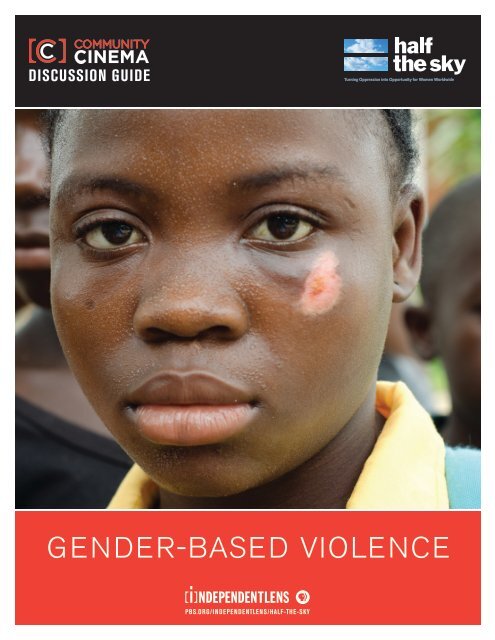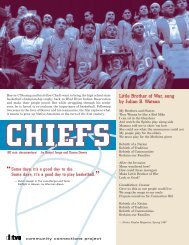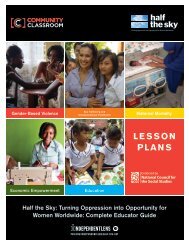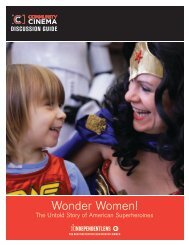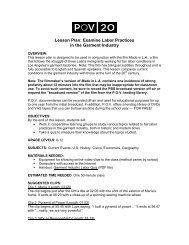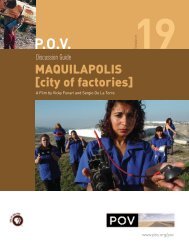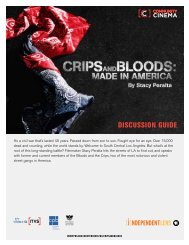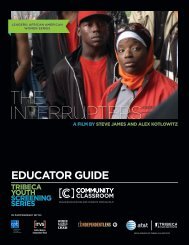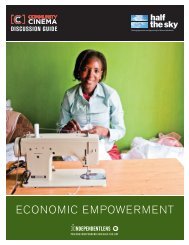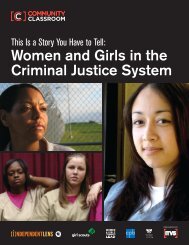Discussion Guide: Gender-Based Violence - ITVS
Discussion Guide: Gender-Based Violence - ITVS
Discussion Guide: Gender-Based Violence - ITVS
Create successful ePaper yourself
Turn your PDF publications into a flip-book with our unique Google optimized e-Paper software.
Using This <strong>Guide</strong>Community Cinema is a rare public forum: a space for people to gather who are connectedby a love of stories, and a belief in their power to change the world. This discussion guideis designed as a tool to facilitate dialogue, and deepen understanding of the complexissues in Half the Sky: Turning Oppression into Opportunity for Women Worldwide. It isalso an invitation to not only sit back and enjoy the show – but to step up and take action.This guide is not meant to be a comprehensive primer on a given topic. Rather, it providesimportant context, and raises thought provoking questions to encourage viewers to thinkmore deeply. We provide suggestions for areas to explore in panel discussions, in theclassroom, in communities, and online. We also provide valuable resources, and connectionsto organizations on the ground that are fighting to make a difference.For information about the program, visit www.communitycinema.orgNOTE TO READERS:This discussion guide gives an overview ofthe entire two-hour Half the Sky: TurningOppression into Opportunity for WomenWorldwide film, and then provides specificbackground information and resourcesfor the country segment that deals with<strong>Gender</strong>-based <strong>Violence</strong> in Sierra Leone.DISCUSSION GUIDE // GENDER-BASED VIOLENCE1
“We wanted to create aunique experience that goesbeyond “issue” filmmaking tosimply tell incredible stories”From the FilmmakerMaro ChermayeffWorking in documentary film has always been an adventure, a pleasure,and a roller coaster ride — but rarely does a project come along thatchanges one’s entire worldview.Making Half the Sky: Turning Oppression into Opportunity for Women Worldwide hastruly been a life-changing endeavor and an honor. The concept for the transmedia projectwas originally brought to me by my fellow executive producers: Jamie Gordon and MikaelaBeardsley. Mikaela had recently produced the film Reporter about the intrepid New YorkTimes columnist Nicholas Kristof. She was very excited when, in conversations in thefield, he talked about his upcoming book to be co-written with his wife Sheryl WuDunnaddressing the struggles and triumphs of women and girls in the developing world thatthey had personally encountered over years of reporting.That book turned out to be the groundbreaking work, also titled Half the Sky: TurningOppression into Opportunity for Women Worldwide, which became an internationalbestseller. The game-changing element of the book is the focus on personal stories thatallow readers to deeply connect with individual, true stories of women and girls facinghorrendous difficulty and inequity. It tackles head on issues such as maternal mortality,sex trafficking, gender-based violence, and forced prostitution — and illustrates the hopeoffered by the life-changing opportunities of education and financial empowerment. Thestorytelling nature of the subject-driven narrative leant itself beautifully to documentary film.As a New Yorker, I knew of Nick’s work as a journalist for The New York Times, and of thehighly regarded Pulitzer Prize-winning articles that Nick and Sheryl had written togetherduring their tumultuous years as reporters based in China, but I had never met eitherof them. Nick and Sheryl believe in the power of social media and the potential of thissubject matter to reach new and diverse audiences through multi-platform content. Thisis where the larger concept of the transmedia project inspired by their book came from.Now, the project is launching on multiple platforms, with a four-hour television series forPBS and international distribution through Fremantle Media; a one hour film for CommunityCinema; free curricula developed for Community Classroom, over 20 short films andeducational modules made in partnership with some of the project’s more than 54 NGOpartners worldwide; mobile games for India and Africa (executive produced with Gamesfor Change with the support of USAID); a social-action Facebook game; and two websites —one housed on PBS.org and another advocacy-based site at halftheskymovement.org.DISCUSSION GUIDE // GENDER-BASED VIOLENCE2
From the FilmmakerAs a filmmaker, the centerpiece ofthe project for me was the documentaryseries. Filmed in ten countries, theseries is inspired by Nick and Sheryl’swork — but also goes beyond the page tofilm new and immediate stories that lendthemselves to the drama that televisiondemands. Our approach was to orchestrate2-week trips to six different countries,following Nick as he reported on an agentof change working to better her own lifeor the lives of women in her community.Joining Nick on each leg of the journeywas a different actress who had experienceadvocating for social issues, butwho was not an expert in the specificissue we were following in that location.Rather, she was there to act as the eyesand ears of the audience, allowing an intimateand honest way into some of thesetough and demanding stories. We had thegood fortune to be joined by Eva Mendesin Sierra Leone, Meg Ryan in Cambodia,Gabrielle Union in Vietnam, Diane Lane inSomaliland, America Ferrera in India, andOlivia Wilde in Kenya.The experience of the shooting was someof the most difficult I have ever experiencedin over twenty years of producingand directing large and complicatedseries. Having directed a ten-hour seriesaboard the USS Nimitz on a six-monthdeployment to Iraq (PBS, Carrier), runaway with a traveling circus (PBS, Circus),and made a film about toxic waste beingdumped on a Native American community(HBO, Mann v. Ford), I was prepared forand yet still stunned by the conditions inwhich most people in the world live. I wasespecially affected by the experiencesof women living under these conditions.From rough terrain to blistering poverty,the situations were incredibly challengingand the issues were often heartbreaking.For example, children being raped as earlyas two and three years old in post-conflictSierra Leone or the staggering reality oftrafficking and sexual slavery of younggirls in Cambodia. But the women weworked with were some of the most amazing,courageous, and admirable women Ihave ever known. The tears often flowed.Two of the more emotional experiencesoccurred while trying to help the fourteenyear-oldFulamatu seek justice againstthe uncle who raped her and two of herfriends, only to watch the case crumble,and during the harrowing brothel raid inCambodia with the fiery Somaly Mam thatfreed several under-age girls being heldin slave-like conditions where they wereforced to work as prostitutes with 10-30clients per day.Working with Nick and Sheryl was aninvaluable and amazing opportunity as adirector. I was so impressed by Nick inthe field as he tenaciously sought out thestory and by Sheryl’s incredible ability tosee the big picture and address the largeglobal issues. I knew I wanted to honortheir work. We all felt from the start thatit should be an epic production, visuallystunning and visceral, showing the amazingplaces we visited and people we metin all their beauty. We wanted the realityof their world to be accessible and yet,at times, shocking — an edge-of-your-seatadventure with global significance. Wewanted to tell true stories, yet also deepenpeople’s experience and understandingof the issues women and girls face inthe developing world. We also believed,and Nick and Sheryl were deeply committedto showing, that the stories couldand should be uplifting and empowering.Even in the darkest of circumstances, wefound the most startling humanity andconfirmation of the human spirit’s resilience.People who engage with all of ourcontent — on the multiple platforms available— will be angry, motivated, inspired,and most important, feel connected to thesubjects and themes. We wanted to createa unique experience that goes beyond“issue” filmmaking to simply tell incrediblestories about the capacity of humanbeings to persevere against all odds andthe restorative power of opportunity inparts of the world that are not “over-there,”but a small leap from our own backyard.DISCUSSION GUIDE // GENDER-BASED VIOLENCE3
The FilmIn 2009, Pulitzer Prize winning-journalists Nicholas Kristof and Sheryl WuDunn published a ground-breakingbook about the oppression of women and girls worldwide. That book was Half the Sky: Turning Oppressioninto Opportunity for Women Worldwide — an instant bestseller that immediately catalyzed an alreadyburgeoning movement to eradicate gender inequality.The landmark PBS documentary series Half the Sky: TurningOppression into Opportunity for Women Worldwide aims toamplify the central message of the book — that women are not theproblem, but the solution — and to bolster the broad and growingmovement for change. Using the story of the book and its impactas a launchpad, the documentary zeroes in on the lives of girls insome of the countries around the world where gender inequalityis at its most extreme and explores the very real ways in whichtheir oppression can be turned to opportunity.Episode OneFeaturing six celebrated American actresses and the commentaryof the world’s leading advocates for gender equality, the film is apassionate call to arms — urging us not only to bear witness to theplight of the world’s women, but also to help to decisively transformtheir oppression into opportunity.<strong>Gender</strong>-<strong>Based</strong> <strong>Violence</strong>Sierra Leone | Eva MendesEpisode TwoSex TraffickingCambodia | Meg RyanEducationVietnam | Gabrielle UnionMaternal MortalitySomaliland | Diane LaneIntergenerational ProstitutionIndia | America FerreraEconomic EmpowermentKenya | Olivia WildeHalf the Sky: Turning Oppression intoOpportunity for Women Worldwide is aspecial presentation of Independent Lensbroadcasting on PBS October 1st and2nd, 2012.Half the Sky: Turning Oppression into Opportunityfor Women Worldwide is a production of Showof Force and Fugitive Films in association withIndependent Television Service (<strong>ITVS</strong>). IndependentLens is jointly curated by <strong>ITVS</strong> and PBS and is fundedby CPB with additional funding provided by PBSand the National Endowment for the Arts.Half the Sky: Turning Oppression into Opportunityfor Women Worldwide is inspired by Nick Kristofand Sheryl WuDunn’s book of the same name.DISCUSSION GUIDE // GENDER-BASED VIOLENCE4
The FilmEpisode OneIn Episode One we follow Nicholas Kristof and three American actresses to developing countries wheregender discrimination is at its most extreme. We explore the shocking extent of gender-based violencein Sierra Leone with Eva Mendes, the global crisis of sex trafficking as experienced by women and girlsin Cambodia with Meg Ryan, and the need for and power of educating girls in Vietnam with GabrielleUnion, where she visits an innovative education program that is transforming, not only the lives of thecountry’s poorest and most vulnerable girls, but also the futures of their families and their communities.Featuring commentary from Sheryl WuDunn and interviews with some of the world’s leading advocates forgender equality — including Hillary Clinton, Michelle Bachelet, and Gloria Steinem — Half the Sky: TurningOppression to Opportunity for Women Worldwide offers a nuanced and moving account of this century’smost pressing problems, and an uplifting, actionable blueprint for change.<strong>Gender</strong>-<strong>Based</strong> <strong>Violence</strong>Our first stop is Sierra Leone, a countryrecovering from years of colonial oppressionand a terrible civil war and which isstill suffering from rampant gender-basedviolence. <strong>Guide</strong>d by Amie Kandeh, thepassionate and dedicated coordinatorof the International Rescue Committee’sWomen’s Protection and EmpowermentProgram in Sierra Leone, Kristof andactress Eva Mendes come face-to-facewith the enormous challenges women andgirls face in a country where rape is practicallythe norm — challenges embodiedby Fulamatu, a buoyant 14-year-old whohopes one day to become a bank manager.When we meet Fulamatu she wasraped repeatedly by a local church pastor— a family friend who is close enough tobe officially considered her uncle. She hadrisked the shame of telling her parentsand the ridicule of her community to breakher silence and press charges against theperpetrator. The outcome is a soberingobject lesson in the insidious effects ofgender-based violence, and the urgentneed to end impunity for the violators.Sex TraffickingAs interviews with WuDunn and some ofthe world’s leading advocates for genderequality explain, in many parts of the worldcultural attitudes and traditions are usedto justify the low status of girls, renderingthem vulnerable to all manner of exploitationand abuse. This is nowhere moreevident than in Cambodia, where thepernicious global problem of sex traffickingis perhaps at its worst. Actress MegRyan joins Kristof in Phnom Penh as hecatches up with Somaly Mam, one of thewomen profiled in the book Half the Sky:Turning Oppression into Opportunity forWomen Worldwide — a woman who washerself a child sex slave and who now hasdedicated her life to rescuing and rehabilitatingothers. As Mam’s story mergesand mingles with those of the girls in hercharge, the horrors of sex trafficking arewrit large — so too is the awesome resilienceof the human spirit and the vast,untapped potential that resides in eachand every one of Mam’s girls.EducationThat potential, WuDunn and our luminaryadvocates tell us, is the key to betteringour world: tap into those girls and theywill change the future. The clarity of thatequation, the elegant cause-and-effect ofit, animates Episode One’s final sequence,in Vietnam, where former Microsoft executiveJohn Wood’s organization Room toRead is transforming the lives of the country’spoorest and most vulnerable girls.Hosted by Bich Vu Thi, program officer ofRoom to Read’s Girl’s Education program,Kristof and actress Gabrielle Union getto know a few of the program’s stars andencounter firsthand the incredible obstacleswhich stand between these girlsand their bright futures. Still, these girlsare almost miraculously undaunted — andfiercely determined to change both theircircumstances and those of their families.The ripple effect of their education evennow is making itself felt — and there is nodoubt that with a little bit of help, a littleencouragement and support, these girlsand the tens of millions of others like themin the developing world will be a powerfularmy for change.Combining vivid, visceral on-the-groundstories with the commentary of a vast andimpressive roster of experts, advocates,and agents of change, Episode One takesus deep into the lives of girls in the developingworld and makes us witness to theirseemingly impossible struggles — at oncechallenging and inspiring us to be a partof the vital, urgent project to empowerthem once and for all.DISCUSSION GUIDE // GENDER-BASED VIOLENCE5
The FilmEpisode TwoEpisode Two continues our journey to the hot spots of gender oppression around the world and highlightsthe courageous work of some of the extraordinary women and men who are taking a stand in the faceof incredible odds. This episode focuses our attention on the role of women in their families and theircommunities — examining the fundamental obstacles that hinder their potential, and charting the ripple effectthat results when that potential is harnessed.Veteran journalist and Half the Sky: TurningOppression into Opportunity for WomenWorldwide co-author Nicholas Kristof isonce again accompanied by a three celebratedAmerican actresses who offer freshand personal perspective on the issues ineach country. Kristof travels to Somalilandwith Diana Lane to examine maternalmortality and female genital mutilation,to India with America Ferrera to exploreintergenerational prostitution, and withOlivia Wilde to Kenya, where the transformativepower of economic empowermentis changing women’s lives and is layingthe groundwork for the next generation. Inthe process, the film considers the centralrole of women in the health and stability oftheir families and communities and establishestheir critical role in the global effortsto eradicate poverty and achieve peace.Featuring on-camera commentary fromSheryl WuDunn and some of the world’smost respected and outspoken advocatesfor gender equality — including MelanneVerveer, Zainab Salbi, and DesmondTutu − Episode Two underscores the fundamentalobstacles to women’s progressand prosperity and celebrates women’sboundless capacity to better our world.Maternal MortalityThe episode begins in Somaliland — anunrecognized country, populated mainlyby nomads, where the average womantoday has a 1-in-12 chance of dying inchildbirth. Joined by actress Diane Lane,Kristof reconnects with Edna Adan, founderof the Edna Adan Maternity Hospitalin Hargeisa. A spry 70-something womanoften and rightly described as a “force ofnature,” Adam is almost single-handedlyrevolutionizing the experience of childbirthin her country — providing medical care towomen who would otherwise have none,training midwives, and fighting tirelesslyagainst female genital mutilation — a traditionalpractice still common in much ofAfrica (and elsewhere), which severelycompromises a woman’s ability to delivera child. In Somaliland, the challengeswomen face in the developing world arestarkly apparent: Poverty and traditionconspire to undermine a woman’s health,directly threatening her life, and having alasting impact on her children’s survivaland ability to thrive.Intergenerational ProstitutionAs WuDunn and our cast of gender equalityadvocates argues, tradition is, in manyways, the greater evil. In too many placesin the world, tradition still is used to marginalizewomen, to keep them down andin their place. This vicious cycle repeatsitself generation after generation, damagingand ending lives and undermining theability of thousands of women improvetheir quality of life and live their fullpotential. The key — as Kristof and actressAmerica Ferrera discover in India — isintervention by someone from the inside:someone like Urmi Basu. A social workerand an educated, middle-class Bengali,Basu has dedicated her life to stoppingthe cycle of intergenerational prostitutionin India, where 90 percent of girls bornto sex workers follow in their mothers’footsteps. What she is up against is neatlyillustrated by one of the young girls inher care, Monisha, who is on the brink ofbeing wrenched out of school and likelysold to a brothel by her own family — afamily that belongs to a sub-caste of sexworkers. What keeps Basu going is girlslike Sushmita — and more to the point,women like Sushmita’s mother, Shoma,who has lived the utter brutality and desolationof prostitution every day of her lifeand desperately wants a different fate forher daughter. Shoma’s hope for her childis the seed of real and lasting change.Economic EmpowermentWhen women have equal control overtheir finances and the financial decisionmakingon the personal, community,and national levels, everyone benefits.WuDunn and the many contributors wholent their voices and considerable expertiseto Half the Sky: Turning Oppressioninto Opportunity for Women Worldwideall stress that putting money in the handsof a poor woman changes everything.During their visit to Kenya, Kristof andOlivia Wilde witness the impact of theeconomic empowerment of women firsthand.In this episode’s final segment,they explore the impact and challenges ofmicrofinance and the ways is transformingthe lives of women and those aroundthem. We begin with Jane Ngoiri, a formersex worker-turned-dressmaker who is nowable to send her four children to school,where they are each at the top of theirclass, and end with Rebecca Lolosoli, aSamburu woman who built a safe havenfor women on the slender thread of a jewelry-makingbusiness. Kristof and Wildesee for themselves the dramatic andtangible transformation that can be set inmotion by a woman with a little money ofher own and a system of support to helpher make the best use of her financial andpersonal resources. Replicate the experimentseveral million times, and the worldwill be an entirely different place.The episode — and the film — ends withan urgent call to action, an invitation tothe viewer to take up the central moralchallenge of our time, and to join a movementthat will tap the immense potentialof women to create a more peaceful andmore prosperous world for us all.DISCUSSION GUIDE // GENDER-BASED VIOLENCE6
“When you have a civil conflict, the normsabout sexual violence change, and itbecomes OK to rape. Then when the warends it’s no longer acceptable to shootpeople, but somehow it’s still acceptableto rape.”– Nicholas Kristof, Half the Sky: TurningOppression into Opportunity for WomenWorldwideIndividuals Featured in<strong>Gender</strong>-<strong>Based</strong> <strong>Violence</strong> inSierra LeoneNicholas KristofJournalist; Co-Author of Half the Sky:Turning Oppression into Opportunity forWomen WorldwideSheryl WuDunnJournalist; Co-Author of Half the Sky:Turning Oppression into Opportunity forWomen WorldwideAmie KandehHelped found the the International RescueCommittee’s (IRC’s) Rainbo Centers;Women’s protection and empowermentcoordinator for the IRC in Sierra LeoneEva MendesActressAbu BakarkKanu Line Manager for the Family SupportUnit in Calaba Town, Sierra LeoneFulamatu TarawailleRainbo Center client; Rape survivorBackground InformationSierra Leone: Civil War and a Legacy of<strong>Violence</strong> against Women and GirlsSierra Leone’s brutal civil war stretched from 1991 to 2002, cost tens of thousandsof lives, and destroyed much of the country’s economy and social infrastructure. Thewar itself was driven by a complex web of forces, including the legacy of centuries ofexploitation by colonial forces, rivalries between ethnic groups, and cross-border regionalconflicts and alliances with countries who had political, military, and economic interests inSierra Leone, especially in regards to its diamonds.Sierra Leone emerged from this war in 2002 with the help of a large United Nations (UN)peacekeeping mission. More than seventeen thousand foreign troops disarmed tens ofthousands of rebels and militia fighters, but several years later, the country still faces thechallenge of reconstruction. Rape, abduction, and sexual slavery are part of the brutallegacy of the civil war, which left over half the country’s population displaced and destitute.The Sierra Leone Civil War was known internationally for its horrific atrocities, but untilrecently, little attention was devoted to abuses directed specifically against women.During the conflict, violence against women was routinely used as a tool of war andwomen and girls were sexually and physically abused in extraordinarily brutal ways,including rape, torture, amputation, forced pregnancy, trafficking, mutilation, and slavery.Although the war has long since ended, the mistreatment of women continues. AsNicholas Kristof explains in Half the Sky: Turning Oppression into Opportunity forWomen Worldwide, “When you have a civil conflict, the norms about sexual violencechange, and it becomes OK to rape. Then when the war ends it’s no longer acceptableto shoot people, but somehow it’s still acceptable to rape.”Sierra Leone’s RainboOver a decade since conflict ended, many fear that rape is more of a problem in postconflictSierra Leone than it was during the war.In an effort to serve the thousands of survivors of sexual and physical violence, Amie Kandeh,women’s protection and empowerment coordinator for the IRC in Sierra Leone, helpedfound and and managed three Rainbo Centers, facilities that provide medical care,counseling, legal aid, and educational support for survivors of sexual violence. These areamong the first sexual-assault referral centers in West Africa, and in their first eight years,they served over nine thousand survivor – 80 percent of whom were children, some asyoung as 2 months old.Amie Kandeh has emerged as one of the leading voices on women’s issues in Sierra Leone,and as a local and a survivor of domestic violence, she brings to her work an intimateunderstanding of the cultural context of violence and the physical and psychological impactit has on the almost 80 percent of Sierra Leonean women who experience it. As part of herwork with the IRC, Amie has also drafted the section of Sierra Leone’s national reproductivehealth policy devoted to violence against women, and has authored a manual on how torecognize sexual abuse in schools. She has organized legal workshops on women’s andchildren’s rights, and has helped gain passage of the <strong>Gender</strong> Acts, three 2007 nationallaws that radically improved the rights of women in Sierra Leone.DISCUSSION GUIDE // GENDER-BASED VIOLENCE7
Background InformationTruth and Reconciliation:Breaking the SilenceSources:»»www.bbc.co.uk/news/world-africa-14094194»»www.rescue.org/video/stop-violence-againstwomen-irc-sierra-leone»»www.un.org/en/africarenewal/vol18no4/184sierraleone.htm»»www.unhchr.ch/Huridocda/Huridoca.nsf/TestFrame/b8dedfadc369a158c1256b81005a84f9?Opendocument»»www.irinnews.org/Report/78853/SIERRA-LEONE-Sex-crimes-continue-in-peacetime»»www.halftheskymovement.org/pages/amie-kandehFollowing the end of the civil war, a Truth and Reconciliation Commission (TRC) wasestablished in Sierra Leone to create an impartial record of the abuses that occurredduring the conflict. Early in their efforts, however, commission investigators found thatgathering information, especially about sexual violence, was not easy. In Sierra Leone, asin many other countries, women and girls confront social taboos against speaking publiclyabout rape and other sexual violence. They are stigmatized in their own communities whenthey admit they have been sexually abused. To help break through such barriers, the UNDevelopment Fund for Women (UNIFEM, now part of UN Women) intervened with advice,training, and other support for TRC staff and especially for the women themselves.<strong>Based</strong> on their findings, the commission urged reforms in Sierra Leone’s legal, judicial,and police systems to make it easier for women to report cases of sexual and domesticviolence and recommended the abolition of the customary practice that obliged the victimof rape to marry the rapist. It also called for the repeal of all statutory and customarylaws that discriminate against women, including in marriage, inheritance, divorce, andproperty ownership.<strong>Violence</strong> against Women and Girls<strong>Gender</strong>-based violence is a global crisis that cuts across race, class, country, and culture,touching the lives of women and girls in every community. According to the UN, approximatelyone out of every three women worldwide has been beaten, coerced into sex, orotherwise abused in her lifetime.Sources:»»www.now.org/issues/violence/stats.html»»www.womenshealth.gov/violence-againstwomen»»www.who.int/mediacentre/factsheets/fs239/en»»www.unwomen.org»»www.care.org/newsroom/articles/2010/02/care-celebrates-introduction-of-internationalviolence-against-women-act-20100208.asp;and»»www.saynotoviolence.orgDISCUSSION GUIDE // GENDER-BASED VIOLENCEFast Facts• One in five women will be a victim of rape or attempted rape in her lifetime.• Women are more likely to be beaten, raped, or killed by a current or former partner thanby any other person, with most studies estimating that 20 to 50 percent of women experiencepartner violence at some point in their lives.• In the United States, a woman is abused, usually by her husband or partner, every 15seconds and is raped every 90 seconds.• In 2005, 1,181 U.S. women were murdered by an intimate partner — that’s an average ofthree women every day.• One hundred and two countries have no specific legal provisions against domestic violence,and in at least fifty-three countries, marital rape is not a prosecutable offence.• Rape has long been used as a weapon of war, and violence against women during orafter armed conflicts has been reported in every war zone. Between two hundred andfifty thousand and five hundred thousand women were raped during the 1994 genocidein Rwanda and between twenty thousand and fifty thousand women were raped duringthe conflict in Bosnia in the early 1990s.• Between five hundred thousand and 2 million people—the majority of them women andchildren — are trafficked annually into situations including prostitution, forced labor, slavery,or servitude. Only 93 countries have some legislative provision prohibiting trafficking inhuman beings.• The UN estimates that approximately five thousand women are murdered each year as aresult of honor killings, but many women’s groups in the Middle East and Southwest Asiasuspect the number is at least four times higher.• In many communities around the world, girls are still seen as less valuable than boys. Asa result, an estimated 60 million girls are “missing" from various populations due to theselective abortion of female fetuses and the mistreatment and neglect of female children.8
“A lot of the brutality against girls andwomen is rooted in deep culturalstereotypes about the worth of women.”– Hillary Clinton, U.S. Secretary of State“It is really hard to find legal remedies torape when you have cultural attitudeslike this where rape is unfortunate butforgivable but being raped is just anunpardonable sin.”– Nicholas Kristof, Half the Sky:Turning Oppression into Opportunityfor Women WorldwideThe Roots of <strong>Violence</strong><strong>Gender</strong>-based violence is not the result of random, individual acts. It is deeply rooted in theunequal power relations between men and women as well as in cultural and social normsthat encourage discrimination against women and the violation of their human rights.The Price of <strong>Violence</strong>The cost of violence against women and girls is extremely high and is a significant obstacleto reducing poverty, achieving gender equality, and improving living standards andeconomic opportunities for women, their families, and their communities. It is also a majorpublic health concern due to the short- and long-term damage to a woman’s reproductiveand physical health, her emotional well-being, and her increased risk factors for diseasessuch as HIV/AIDS.In addition to the pain and suffering of the individual women and their families, the socialand economic costs are staggering. Treatment and support programs needed for abusedwomen and children, legal and judicial services employed to bring perpetrators to justice,and lost employment and productivity resulting from physical and emotional injury puta significant economic strain on under-resourced communities and society as a whole.The cost of intimate partner violence in the United States alone is approximately $5.9 billionper year: $4.1 billion for direct medical and health care services and $1.8 billion forlosses in productivity.Barriers to Change:A Culture of Silenceand ImpunityAlthough it is widespread, violence against women and girls goes widely unreporteddue to factors such as fear of retribution, lack of economic resources, concern for children,inadequate social services, and ineffective legal systems. In addition, few countriesprovide appropriate training for the police, judicial, and medical staff who are the firstresponders for women and girls during and after violent events. As a result, victims of violenceare left vulnerable to further abuse from the systems and institutions that are meantto protect them, and the perpetrators are often left unpunished.DISCUSSION GUIDE // GENDER-BASED VIOLENCE9
“I’d like to put him in jail and throwthe key into the ocean.”– Fulamatu Tarawaille, Rape survivor,Rainbo Center, Sierra LeoneWhat is Needed?<strong>Violence</strong> against women and girls is a worldwide crisis, but there is a global movementto challenge the attitudes and institutions that make this abusive behavior possible.Research from the UN, the World Health Organization (WHO), and Amnesty Internationalconcludes that the most effective strategy for addressing gender-based violence isthrough coordinated efforts by international and local institutions to raise public awareness,increase political will, and provide resources for preventing and responding to allforms of violence against women and girls. Strategies include:• Make the prevention of violence against women and girls a political priority on the international,national, and local levels.• Pass legislation that specifically addresses gender-based violence, and establish a systemof oversight to make sure the laws are enforced.• Provide ongoing training to police, judicial staff, and medical staff, who are the primarysources of protection and support for women and girls in crisis.• Establish effective outreach and education programs that target both women and menfrom early childhood.• Support programs that make primary, secondary, and university education accessible toall girls and empower women to become financially independent.• Ensure the participation of women in all areas of society and support the appointment ofwomen to leadership positions at the local, national, and international levels.DISCUSSION GUIDE // GENDER-BASED VIOLENCE10
What is Needed?Defining <strong>Violence</strong> againstWomen and GirlsSources:»»www.unfpa.org/gender/violence.htm»»www.now.org/issues/violence/stats.html»»www.womenshealth.gov/violence-against-women»»www.who.int/mediacentre/factsheets/fs239/en»»www.cdc.gov/ncipc/pub-res/ipv_cost/ipvbookfinal-feb18.pdf»»www.unwomen.org»»www.care.org/newsroom/articles/2010/02/carecelebrates-introduction-of-international-violenceagainst-women-act-20100208.asp»»www.saynotoviolence.orgThe Declaration on the Elimination of <strong>Violence</strong> against Women, adopted by the UNGeneral Assembly in 1993, defines violence against women as “any act of gender-basedviolence that results in, or is likely to result in, physical, sexual, or psychological harm orsuffering to women, including threats of such acts, coercion or arbitrary deprivation of liberty,whether occurring in public or private life.” This includes but is not limited to:• Physical abuse. Hitting, slapping, shoving, grabbing, pinching, biting, hair pulling, etc. aretypes of physical abuse. This type of abuse also includes denying medical care or forcingalcohol and/or drug use on the victim.• Sexual abuse and rape. These involve coercing or attempting to coerce any sexual contactor behavior without consent. Sexual abuse includes attacks on sexual parts of thebody, marital rape, forcing sex after physical violence has occurred, or treating anotherperson in a sexually demeaning manner.• Domestic violence. This is a pattern of abusive behavior in any relationship that is usedby one partner to gain or maintain power and control over another intimate partner. Thiscan be physical, sexual, emotional, economic, or psychological actions or threats. It alsoincludes any behaviors that intimidate, manipulate, humiliate, isolate, frighten, terrorize,coerce, threaten, blame, hurt, injure, or wound someone.• Emotional and psychological abuse. Undermining an individual’s sense of self-worth and/or self-esteem is abusive. This may include, but is not limited to, constant criticism, namecalling,damaging a woman’s relationship with her children, causing fear by intimidation,and threatening physical harm.• Sexual harassment and intimidation. These involve unwelcome sexual advances, requestsfor sexual favors, and other verbal or physical conduct of a sexual nature.• Human trafficking. This involves using force, coercion, abduction, fraud, deception, power,and threats of harm in order to take unlawful ownership of an individual and exploit them.Exploitation often involves forced prostitution, forced labor, and indentured servitude.• Honor killing. This is an act of vengeance, usually murder, committed against a femalefamily member who is believed to have brought dishonor to the family. A woman can betargeted for a variety of reasons, including refusing to enter into an arranged marriage,being the victim of a sexual assault, seeking a divorce (even from an abusive husband), orallegedly committing adultery.• Female genital mutilation/cutting. Female genital mutilation (FGM), also known as femalegenital cutting (FGC) includes procedures that intentionally alter or cause injury to thefemale genital organs for nonmedical reasons. It is mostly carried out on young girlsbetween infancy and age 15 and is motivated by a mix of cultural, religious, and socialfactors within familiesand communities.DISCUSSION GUIDE // GENDER-BASED VIOLENCE11
Topics and Issues Relevantto the Film.A screening of <strong>Gender</strong>-based <strong>Violence</strong>in Sierra Leone can be used to sparkinterest in any of the following topicsand inspire both individual and communityaction. In planning a screening,consider finding speakers, panelists, ordiscussion leaders who have expertisein one or more of the following areas:Women’s empowerment<strong>Gender</strong> issues<strong>Gender</strong>-based violenceSexual assault and rapeSexual harassmentHuman rightsGlobal povertyInternational developmentMillennium Development GoalsThinking More Deeply1. What insights did <strong>Gender</strong>-<strong>Based</strong> <strong>Violence</strong> in Sierra Leone give you about violenceagainst women and girls around the world? What information surprised you the most?2. Why is gender-based violence an important issue to tackle? What are some of the rippleeffects of violence against women on their families, communities, and societies?3. Michelle Bachelet, executive director of UN Women, says in the film, “You see violenceagainst women in rich places, highly educated families, in very low-income families in allregions of the world.” Before seeing this film, did you think of violence against womenand girls as a worldwide crisis? In what ways, if any, is gender-based violence an issue inyour community?4. How is violence against women and girls connected to the cycle of poverty? What role, ifany, could access to education and economic empowerment play in combating genderbasedviolence?5. In the film, Amie Kandeh says, “When you look at the root cause of violence against women,it is about power and control.” What does this statement mean to you? Do you agree withKandeh? If gender-based violence is a global crisis, affecting diverse communities and womenfrom all walks of life, what factors are driving men’s need to control women?6. How significant is it to the success of Kandeh’s work that she is from Sierra Leone? Doyou think it is possible for individuals from wealthy countries or international organizationsto be effective in the developing world or communities other than their own? What arethe benefits and challenges?7. Kandeh says that “the IRC has responded to about ten thousand sexual assault survivors”since the program began in Sierra Leone and “there’s not even 1 percent of thosecases that have been convicted.” What are some of the barriers that get in the way ofbringing perpetrators to justice? What are some of the consequences for survivors whocome forward to seek prosecution? How do these challenges compare with survivors’experiences in your community? Can you identify any parallels?8. Hillary Clinton draws a parallel between the attitudes toward and treatment of womenaround the world today and the experience of African American slaves during the heightof the slave trade, explaining that both communities were not seen as “fully human”– theywere both “some other kind of being.” Do you think this is an apt parallel to draw? Why orwhy not?9. Nicholas Kristof actively participates in Fulamatu’s story, even helping the authorities trackdown the accused child rapist. He considers the journalistic ethics of his involvement andconcludes that he is comfortable with his decision. What do you think about his decision?Is there a distance that journalists should maintain in order to remain objective? Is it moreethical to simply observe and report or to actively participate?10. Kristof says, “It is really hard to find legal remedies to rape when you have culturalattitudes like this where rape is unfortunate but forgivable, but being raped is just anunpardonable sin.” What do you think is needed to reduce and eventually eradicategender-based violence? What responsibility do governments and international bodieslike the UN and the International Criminal Court? What role can you play?DISCUSSION GUIDE // GENDER-BASED VIOLENCE12
Suggestions for ActionTogether with other audience members, brainstorm actions that you might take as an individual and thatpeople might do as a group. Here are some ideas to get you started:1. Join the global movement to educate women and girlsand improve the quality of education for all children. Visitthe Half the Sky: Turning Oppression into Opportunity forWomen Worldwide movement website to learn more about theissue and find out how to host a screening with your friends,family, community, or organization and facilitate a discussion ofthe film and the best-selling book that inspired it.www.halftheskymovement.org2. Mobilize your community and become part of the “Say NO—UNiTE to End <strong>Violence</strong> against Women” campaign. This campaignwas launched in 2009 by UN Women to engage peoplefrom all walks of life online and on the ground to end genderbasedviolence in all its forms. The “Say NO–UNiTE” tool kit hasa range of resources, tips, multimedia tools, and step-by-stepguides for creating your own campaign, organizing communityevents, and starting local clubs to galvanize support.Say NO—UNiTE to End <strong>Violence</strong> against Women:www.saynotoviolence.orgSay NO–UNiTE Organizer’s Tool Kit:saynotoviolence.org/about-say-no/organizers-toolkit3. Take action to empower survivors of violence in Sierra Leoneand help to provide support and services to girls and womenaround the world who need them most. The InternationalRescue Committee’s Rainbo Centers in Sierra Leone haveprovided medical care, counseling, legal aid, and educationalsupport for over ten thousand survivors of sexual violence. Visitthe IRC’s website to find out more about their lifesaving workin Sierra Leone and in more than 40 other countries around theworld: www.rescue.org.4. Find out more about how ending gender-based violence can helpend poverty. In September 2000, the United Nations signed theMillennium Development Goals (MDGs) with the aim of halvingthe number of people living in poverty, reducing child mortality,fighting disease, and improving social and economic conditionsin the world’s poorest countries by 2015. Learn more about theMillennium Campaign’s focus on women and find out how youcan help:United Nations Millennium Development Goals:www.un.org/millenniumgoalsEnd Poverty 2015: www.endpoverty2015.orgThe “Get Involved” section of the UN MDGs website:www.un.org/millenniumgoals/getinvolved.shtmlThe “Millennium Development Goals” section of the UNWomen website: www.unifem.org/gender_issues/millennium_development_goalsMDG Monitor: www.mdgmonitor.org5. Take back the night! The Take Back The Night Foundation (TBTN)serves to create safe communities and bring an end to sexualassault, domestic violence, dating violence, sexual abuse, and allother forms of sexual violence. TBTN empowers survivors in thehealing process and inspires responsibility in all. Visit the websiteto find out how to plan a “Shine Your Light Walk” to demonstrateyour community’s commitment to ending sexual violence and takea stand in solidarity with survivors: www.takebackthenight.org.DISCUSSION GUIDE // GENDER-BASED VIOLENCE13
Resourceswww.halftheskymovement.org–This is the official website for theHalf The Sky: Turning Oppression Into Opportunity For WomenWorldwide movement, as well as for the book and film of thesame name.www.rescue.org – The International Rescue Committee (IRC)responds to the world’s worst humanitarian crises and helpspeople to survive and rebuild their lives.www.careinternational.org – CARE International is an organizationthat is fighting poverty and injustice in more than 70 countriesaround the world and helping 65 million people each year findroutes out of poverty.endviolence.un.org – UNiTE to End <strong>Violence</strong> against Women waslaunched in 2009 by UN Women to engage people from all walksof life to end gender-based violence in all its forms.www.gems-girls.org – Girls Educational and Mentoring Services(GEMS) is the only organization in New York State specificallydesigned to serve girls and young women who have experiencedcommercial sexual exploitation and domestic trafficking and theirwork has put them on the forefront of the national movement toend the sexual slavery of women.www.futureswithoutviolence.org – Futures without <strong>Violence</strong> worksto prevent and end violence against women and children aroundthe world.www.rainn.org – The Rape, Abuse, and Incest National Network(RAINN) is the nation’s largest anti-sexual violence organizationand created and operates the National Sexual Assault Hotline:1-800-656-HOPE. The online version of the hotline can be foundat apps.rainn.org/ohl-bridge.www.vetoviolence.org/stryve – Striving to Reduce Youth <strong>Violence</strong>Everywhere (STRYVE) is a national initiative, led by the Centersfor Disease Control and Prevention (CDC), which takes a publichealth approach to preventing youth violence before it starts.www.nnedv.org – The National Network to End Domestic <strong>Violence</strong>(NNEDV), a social change organization, is dedicated to creatinga social, political, and economic environment in which violenceagainst women no longer exists.www.now.org – The National Organization for Women (NOW) isthe largest organization of feminist activists in the United Statesand works to bring about equality for all women.www.amnesty.org – Amnesty International is a worldwide movementof people who campaign for internationally recognizedhuman rights for all.DISCUSSION GUIDE // GENDER-BASED VIOLENCEwww.msf.org – Médecins Sans Frontières, also known as DoctorsWithout Borders, is an international, independent, medical humanitarianorganization that delivers emergency aid to people affectedby armed conflict, epidemics, health care exclusion, and natural orman-made disasters.www.savethechildren.org – Save the Children is an organizationthat works to save and improve children’s lives in more than 50countries worldwide.www.unfpa.org – The United Nations Population Fund (UNFPA)is an international development agency that promotes the right ofevery woman, man, and child to enjoy a life of health and equalopportunity.www.worldvision.org – Recognizing women and girls as criticalpartners in development, the Christian humanitarian organizationWorld Vision works to equip, protect, and advocate for women innearly one hundred countries.A Message from New VideoNew Video, a Cinedigm company, is a leading entertainmentdistributor and the largest aggregator of independent digitalcontent worldwide. New Video’s Docurama Films is proud tooffer Half the Sky: Turning Oppression into Opportunity forWomen Worldwide as part of its roster of acclaimed, awardwinningdocumentaries. Here are ways in which grassrootsorganizers and home video consumers might utilize the DVD tospread the message of the film and benefit their organizations:• Affiliate Program: New Video offers a free Affiliate Program thatallows organizations or individuals to earn a 10 percent referral feeoff every DVD purchased through a unique tracking link on theirwebsites, social media properties, and signatures. (www.newvideo.com/about/affiliates) New Video is very hands-on with enrollees,helping them reach their highest potential within the program: callingout the “donation” from the program, messaging that purchasingdirectly supports the independent film community, etc.• Wholesale Orders: Bulk orders start at just ten units (nonreturnable),with discounts increasing at tiered intervals. Great for fundraisingincentives, membership premiums, etc.• DVD Giveaways: New Video can offer a small quantity of DVDsfor giveaways in exchange for promotion on social media and webproperties• Member Discounts: New Video can create unique discountcodes for organizations to offer its members a discounted rate onthe DVD• Social Media Engagement: New Video can post or retweet organizationsthat are spreading the word about a release or engagingin a giveaway or screening event• Please contact Vanessa at vvarous@newvideo.com if you areinterested in the above options.14
CreditsWRITERAllison MilewskiPhotoForward Founder andArts and Media Education Specialist<strong>ITVS</strong> ENGAGEMENT & EDUCATION TEAMSara Brissenden-SmithNational Community Engagement CoordinatorChi DoAssociate Director of Community Engagement & EducationLocsi FerraThematic Campaign Manager, Women and Girls LeadRenee GaschEngagement & Education CoordinatorNallaly JimenezNational Community Engagement AssistantAnnelise WunderlichEducation ManagerDESIGNTina BenanavMichael SilvaCOPY EDITORJocelyn TruittThanks to those who reviewed this guide:Maro ChermayeffDirector, Half the Sky: Turning Oppression into Opportunity forWomen WorldwideRachel KoteenCo-Producer, Show of Force<strong>ITVS</strong>Independent Television Service (<strong>ITVS</strong>) funds, presents, and promotes award-winningindependently produced documentaries and dramas on public television and cable,innovative new media projects on the Web, and the Emmy ® Award-winning seriesIndependent Lens on PBS. <strong>ITVS</strong> receives core funding from the Corporation for PublicBroadcasting, a private corporation funded by the American people. Women and GirlsLead is a strategic public media initiative to support and sustain a growing internationalmovement to empower women and girls, their communities, and future generations. Tolearn more, visit itvs.org/women-and-girls-leadSHOW OF FORCEDedicated to creating feature documentaries and television series events of the highestcaliber, Show of Force is known for dynamic, character-driven storytelling that consistentlyengages, entertains, and inspires. Show of Force is a media production companyrepresented by CAA (Creative Artists Agency), with 20 years of combined experienceand excellence between partners Maro Chermayeff and Jeff Dupre. They have producedover 20 hours of television and media content per year with a staff of excellent youngproducers and are the recipients of numerous awards and accolades for their work onboth U.S. and international media broadcasts. Show of Force is the production companyoverseeing the multiple platforms of the Half the Sky: Turning Oppression intoOpportunity for Women Worldwide movement. To learn more, visit showofforce.comWyncoteFoundationnational center forMEDIA ENGAGEMENTIndependent Television Service (<strong>ITVS</strong>) email: cinema@itvs.org web: www.communitycinema.org


